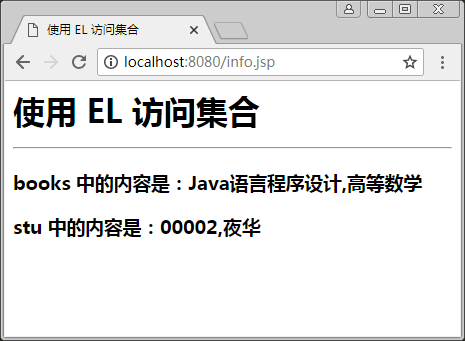使用EL表达式访问集合
在 EL 表达式中,同样可以获取集合的数据,这些集合可能是 Vector、List、Map、数组等。可以在 JSP 中获取这些对象,继而显示其中的内容,其语法格式如下:
其中,collection 代表集合对象的名称。例如:
表示集合 books 中下标为 0 的元素。
上面表示的是一维集合,如数组、List 等,若操作的集合为二维集合,如 HashMap,其值是 key 和 value 值对的形式,则值 (value) 可以这样显示:
例如:
表示显示名为 pi 的 HashMap 中的 key 为 ID 的元素的值。下面是通过 EL 表达式访问集合的一个案例。
【例1】通过 EL 表达式访问集合(collection_demo.jsp):
程序运行结果如图 1 所示。

图1 使用EL访问集合
${collection [序号]}
其中,collection 代表集合对象的名称。例如:
${books [0]}
表示集合 books 中下标为 0 的元素。
上面表示的是一维集合,如数组、List 等,若操作的集合为二维集合,如 HashMap,其值是 key 和 value 值对的形式,则值 (value) 可以这样显示:
${collection.key}
例如:
${p1.ID}
表示显示名为 pi 的 HashMap 中的 key 为 ID 的元素的值。下面是通过 EL 表达式访问集合的一个案例。
【例1】通过 EL 表达式访问集合(collection_demo.jsp):
<%@ page language="java" contentType="text/html;charset=utf-8" %>
<%@ page import="java.util.*" %>
<html>
<head>
<title>使用 EL 访问集合</title>
</head>
<body>
<h1>使用 EL 访问集合</ h1>
<hr/>
<%
List books=new ArrayList();
books.add("Java语言程序设计");
books.add("高等数学");
session.setAttribute("books",books);
HashMap stu=new HashMap();
stu.put("stuno","00002");
stu.put("stuname","夜华");
session.setAttribute("stu",stu);
%>
<h3>books 中的内容是:${books[0]},${books[1]}</h3>
<h3>stu 中的内容是:${stu.stuno},${stu.stuname}</h3>
</body>
</html>
程序运行结果如图 1 所示。

图1 使用EL访问集合
所有教程
- C语言入门
- C语言编译器
- C语言项目案例
- 数据结构
- C++
- STL
- C++11
- socket
- GCC
- GDB
- Makefile
- OpenCV
- Qt教程
- Unity 3D
- UE4
- 游戏引擎
- Python
- Python并发编程
- TensorFlow
- Django
- NumPy
- Linux
- Shell
- Java教程
- 设计模式
- Java Swing
- Servlet
- JSP教程
- Struts2
- Maven
- Spring
- Spring MVC
- Spring Boot
- Spring Cloud
- Hibernate
- Mybatis
- MySQL教程
- MySQL函数
- NoSQL
- Redis
- MongoDB
- HBase
- Go语言
- C#
- MATLAB
- JavaScript
- Bootstrap
- HTML
- CSS教程
- PHP
- 汇编语言
- TCP/IP
- vi命令
- Android教程
- 区块链
- Docker
- 大数据
- 云计算